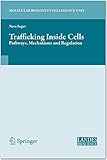Trafficking Inside Cells : Pathways, Mechanisms and Regulation / by Nava Segev.
Tipo de material: TextoSeries Molecular Biology Intelligence UnitEditor: New York, NY : Springer New York, 2009Descripción: recurso en líneaTipo de contenido:
TextoSeries Molecular Biology Intelligence UnitEditor: New York, NY : Springer New York, 2009Descripción: recurso en líneaTipo de contenido: - texto
- computadora
- recurso en línea
- 9780387938776
- R-RZ
Springer eBooks
Compartments and Pathways -- Overview of Intracellular Compartments and Trafficking Pathways -- How We Study Protein Transport -- The Golgi Apparatus -- The Endocytic Pathway -- Regulated Secretion -- Mechanisms -- Overview of Protein Trafficking Mechanisms -- Entry into the Endoplasmic Reticulum: Protein Translocation, Folding and Quality Control -- COP-Mediated Vesicle Transport -- Clathrin-Mediated Endocytosis -- Biogenesis of Dense-Core Secretory Granules -- Lipid-Dependent Membrane Remodelling in Protein Trafficking -- Carrier Motility -- Tethering Factors -- Intracellular Membrane Fusion -- Regulation and Coordination with Other Cellular Processes -- Regulation and Coordination of Intracellular Trafficking: An Overview -- Regulation of Protein Trafficking by GTP-Binding Proteins -- Posttranslational Control of Protein Trafficking in the Post-Golgi Secretory and Endocytic Pathway -- Actin Doesn’t Do the Locomotion: Secretion Drives Cell Polarization -- Intracellular Trafficking and Signaling: The Role of Endocytic Rab GTPase -- The Exocytic Pathway and Development.
The human body is made up of trillions of tiny cells that cannot be seen by the naked eye. The functioning units inside these cells are macromolecules that need to travel in the three-dimensional cell-space to distances ten thousand times their size. This movement is highly ordered, requires energy and takes place on molecular tracks that serve as a sophisticated transport system—somewhat equivalent to the multimodal rail-highway-river networks of large metropolises. All the systems of the human body depend on the efficient delivery of macromolecules to their right destination at the right time—both within and between cells. Breakdown of this traffic system results in a variety of diseases including diabetes, cancer and heart disease, as well as immunological, neurological and developmental disorders. During the last half a century, scientists have made a quantum leap in unraveling the mysteries of trafficking inside cells. The three sections of this book together cover the past, present and future of this rapidly developing and intriguing field.
Para consulta fuera de la UANL se requiere clave de acceso remoto.


